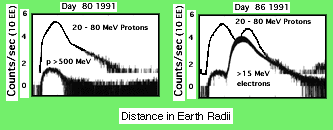
#12H. The Radiation Belt--HistoryThe idea that the inner radiation belt came from neutrons splashed out of the atmosphere was independently proposed at the end of 1958, the year in which the belt was discovered, by three investigators--S. Fred Singer (U. of Maryland), Paul Kellogg (U. of Minnesota) and S.N. Vernov (USSR). It was confirmed in 1959 by a rocket fired into the radiation belt, carrying special photographic film in which the tracks of high-energy protons were recorded: the nose-cone with the film was retrieved and the film was developed and examined.The artificial radiation belts from the Argus experiment were located in the "slot" between the two belts and their lifetimes of a few weeks underscored the temporary nature of trapping there (especially for electrons produced just above the atmosphere). In October-November the USSR exploded three rather large bombs in space, in the outer belt region, and their electrons also persisted for a number of weeks. On the other hand, the "Starfish" H-bomb test, conducted by the USAir Force in July 1962 above Johnston Island west of Hawaii, injected high-energy electrons into the stable inner radiation belt, many of them lasting a year or two, some even longer. The intense artificial radiation belt from that blast disabled three satellites. Nuclear explosions in space were banned in 1967 by an international treaty, but nature itself sometimes steps in. On March 24, 1991 a strong interplanetary shock, originating on the Sun, hit the Earth's atmosphere, compressed it greatly and sent a secondary shock through its interior. Like surfers riding a wave, trapped electrons and ions rode this shock and within a minute or so created a new radiation belt just outside the inner belt (picture below). The new belt contained both electrons and protons of high energy (15-20 Mev), and it disabled the MARECS-I satellite and degraded GOES-7. The new belt was observed by the US Air Force satellite CRRES and was still in place (somewhat weakened) when CRRES stopped transmitting at the end of 1991.
|

| (Above) The profile of the radiation belt observed by CRRES before and after the magnetic storm of March 1991. Horizontal axis measures distance from Earth, vertical axis gives radiation intensity, and the higher curve refers to energetic protons. Before the event, that curve has just one peak, representing the inner radiation belt; afterwards, it has two. The left edge is at the surface of the Earth (1 Earth radius = 1 RE), the peaks of the "old" inner belt (left panel) occur around 1.5 RE and the electron and ion peaks added by the new belt are at about 2.1-2.2 RE. |
The giant planets--Jupiter, Saturn, Uranus and Neptune--are all intensely magnetized and all have radiation belts, similar in some ways to the Earth's outer belt. The strongest is that of Jupiter, and radio signals from it were first detected in 1955 but were not understood at the time. Jupiter's belt is strongly affected by its large moon Io, which loads it with many ions of sulfur and sodium from the moon's "sulfur volcanos", and whose ionosphere interacts with Jupiter's magnetic field. Saturn seems to have in addition an "inner belt" similar to the Earth's, observed by Pioneer 11 during its 1979 fly-by. It is probably caused by cosmic rays which eject neutrons from the planet's famous rings.
|
"Exploration" home page (index) Glossary
Next Stop: #13. Energetic particles
 Official GSFC Home Page .........
Official GSFC Home Page .........
 NASA WWW Home Page
NASA WWW Home Page
Last updated March 13, 1999